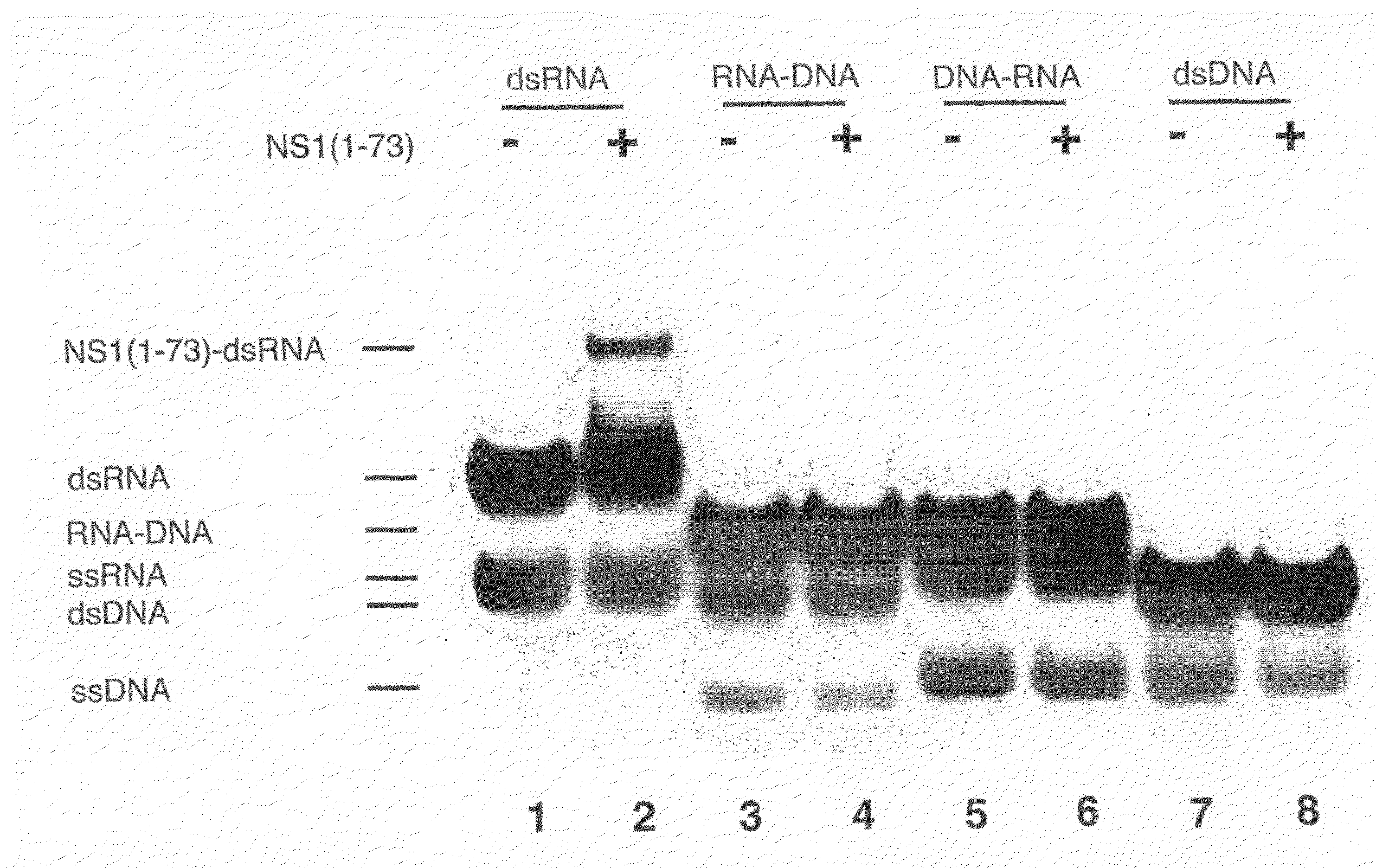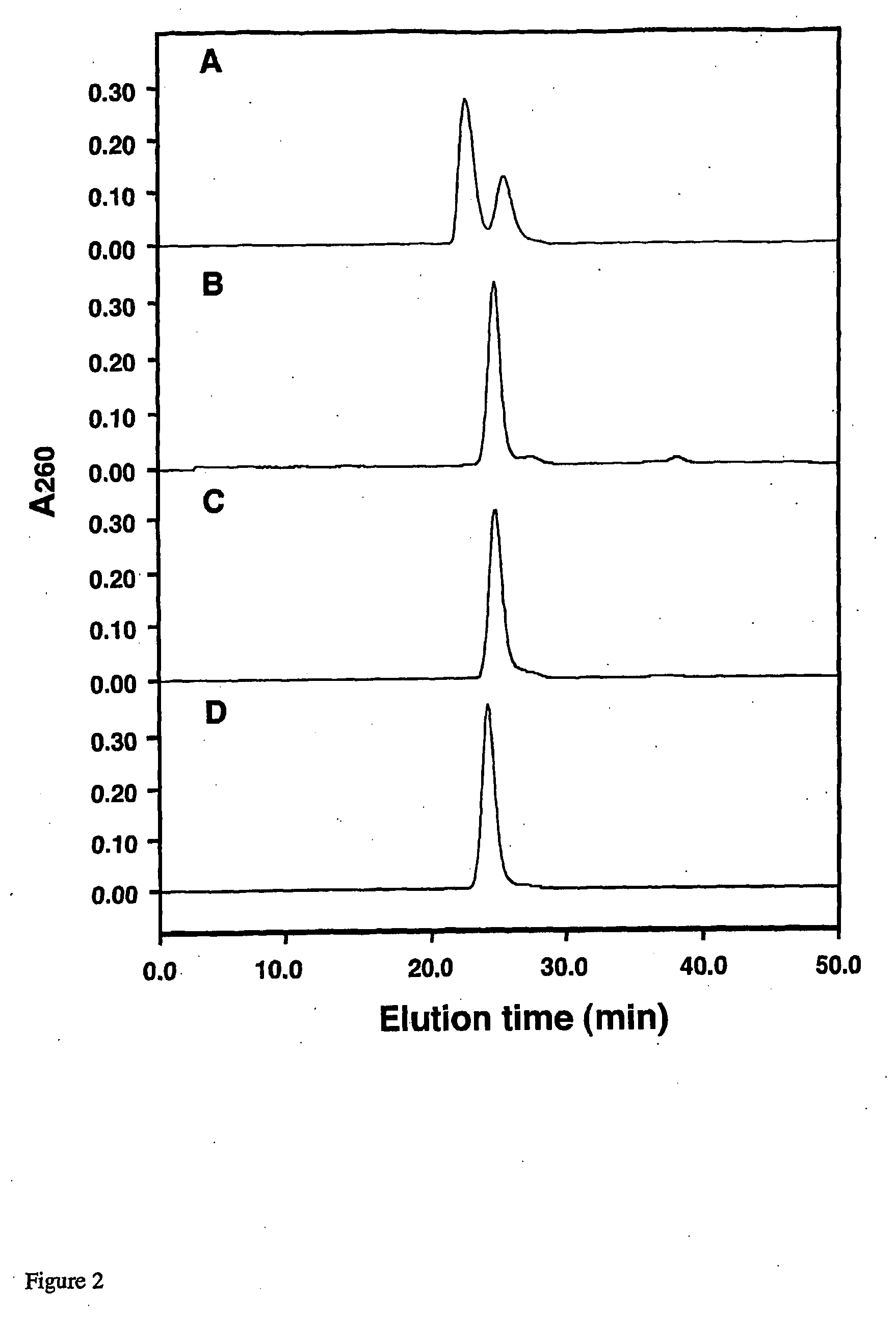Process for Designing Inhibitors of Influenza Virus Structural Protein 1
- Summary
- Abstract
- Description
- Claims
- Application Information
AI Technical Summary
Benefits of technology
Problems solved by technology
Method used
Image
Examples
example 1
[0117]E. coli BL21 (DE3) cell cultures were transformed with a pET11a expression vector encoding NS1A(1-73), grown at 37° C., and then induced with 1 mM IPTG at OD600=0.6 for 5 hours in MJ minimal medium (Jansson et al., (1996) J. Biomol. NMR 7, 131-141.) containing uniformly enriched 15NH4Cl and 13C6-glucose as the sole nitrogen and carbon sources, respectively. Cells were broken by sonication, followed by centrifugation at 100,000×g at 4° C. for 1 hour. Proteins were then purified from the supernatant by ion exchange and gel filtration chromatography using Pharmacia FPLC systems according to a procedure described elsewhere. (Qian et al., (1995) RNA 1, 948-956.) The overall yield of purified NS1A(1-73) was about 5 mg / l of culture medium. Protein concentrations were determined by absorbance at 280 nm (A280) using a molar extinction coefficient (ε280) for the monomer of 5750 M−1cm−1.
example 2
Synthesis and Purification of RNA Oligomers
[0118]Two single-stranded (ss) 16-nucleotide (16-nt) RNAs, CCAUCCUCUACAGGCG (sense) and CGCCUGUAGAGGAUGG (antisense), were chemically synthesized using standard phosphoramidite chemistry (Wincott et al., (1995) Nucleic Acids Res. 23, 2677-2684) on a DNA / RNA synthesizer Model 392 (Applied Biosystems, Inc.) Both RNA oligomers were then desalted over Bio-Rad Econo-Pac 10DG columns and purified by preparative gel electrophoresis on 20% (w / v) acrylamide, 7M urea denaturing gels. The appropriate product bands, visualized by UV shadowing, were cut out, crushed, and extracted into 90 mM Tris-borate, 2 mM EDTA, pH 8.0 buffer by gentle rocking overnight. The resulting solutions were concentrated by lyophilization and desalted again using Econo-Pac 10DG columns. Purified RNA oligomers are then lyophilized and stored at −20°. Analogous 16-nt sense and antisense DNA strands containing the same sequence can be purchased from Genosys Biotechnologies, Inc....
example 3
Polyacrylamide Gel Shift Binding Assay
[0119]The single-stranded 16-nt synthetic RNA and DNA oligonucleotides were labeled at their 5 ends with [γ32P]ATP using T4 polynucleotide kinase and purified by denaturing urea-PAGE. Approximate 1:1 molar ratios of single-stranded (ss) sense RNA (or DNA) and antisense RNA (or DNA) were mixed in 50 mM Tris, 100 mM NaCl, pH 8.0 buffer. Solutions were heated to 90° C. for two minutes and then slowly cooled down to room temperature to anneal the duplexes. NS1A(1-73), final concentration of 0.4 μM, was added to each of the four double-stranded (ds) nucleic acids (dsRNA (RR), RNA-DNA (RD) and DNA-RNA (DR) hybrids, and dsDNA (DD), 10,000 cpm, final concentration ≈1 nM) in 20 μl of binding buffer (50 mM Tris-glycine, 8% glycerol, 1 mM dithiothreitol, 50 ng / μl tRNA, 40 units of RNasin, pH 8.8). The reaction mixture was incubated on ice for 30 min. The protein-nucleic acid complexes were resolved from free ds or ss oligomers by 15% nondenatuting PAGE at ...
PUM
| Property | Measurement | Unit |
|---|---|---|
| Dimensionless property | aaaaa | aaaaa |
| Dimensionless property | aaaaa | aaaaa |
| Length | aaaaa | aaaaa |
Abstract
Description
Claims
Application Information
 Login to View More
Login to View More - R&D
- Intellectual Property
- Life Sciences
- Materials
- Tech Scout
- Unparalleled Data Quality
- Higher Quality Content
- 60% Fewer Hallucinations
Browse by: Latest US Patents, China's latest patents, Technical Efficacy Thesaurus, Application Domain, Technology Topic, Popular Technical Reports.
© 2025 PatSnap. All rights reserved.Legal|Privacy policy|Modern Slavery Act Transparency Statement|Sitemap|About US| Contact US: help@patsnap.com



